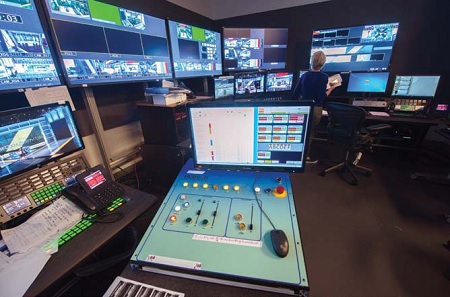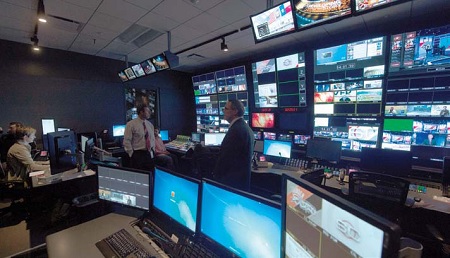Switching to IP

Master control at ESPN’s new DC-2OTTAWA, ONTARIO, CANADA—Video over IP is becoming a staple of TV broadcast engineering, and the trend dominating new facility design. A case in point: ESPN’s new Digital Center 2 (DC-2) is using JPEG2000 video-over-IP technology for moving signals in, around and out of its 194,000 square-foot production facility in Bristol, Conn.
Despite this, the sports network is not using video-over-IP in master control as of yet, according to Mitch Rymanowski, vice president of technology and engineering for ESPN. “Although we do have an initiative called ‘MPEG MCR’ underway to make this happen, the fact is that vendor equipment is not quite there yet for moving switching from SDI to IP,” he said.
ESPN isn’t alone. SDI-based switching remains the way that broadcasters produce live TV these days, even in a world of video-over-IP advances. This is because the two technologies are built upon fundamentally different architectures: SDI-based/switching and routing handle individual uncompressed video streams that are frame-synchronized to each other. Video-over-IP signals are packet-based, with many streams intermingled on a common pipeline. This makes standard A/B video switching impossible without some form of technical workaround; primarily because IP transport was never designed nor meant to be a real-time switchable signal format.
The same problems extend to video-over-IP routing. “You can’t simply forklift an IP-based router in place of an existing SDI system,” said Stan Moote, a TV engineering consultant who has won several technical Emmys. “An SDI router is a full bandwidth device with only one signal per channel, whereas an IP router has many signals moving down each Ethernet path.”
END-TO-END
If video-over-IP presents real-time switching with such issues, a logical response might be, “why bother?” After all, the current approach of keeping master control in a real-time SDI switching environment seems to work. Once the live feed has been mixed in SDI, it is easy to encode it for IP distribution; as many networks such as ESPN are already doing.

ESPN’s new Digital Center still uses SDI for switching. The answer is that an IP-based master control could be fully integrated into a TV broadcaster’s existing video-over-IP network. “This would mean that everything you have, from editing stations to printers, would be on the same LAN, and just as easily added or removed as a desktop computer,” Moote said. “The sheer power of real-time sharing and control would be astounding. That’s why a fully IP-based TV station is today’s Holy Grail for broadcast engineers.”
Among companies promoting an all-IP TV station is Cinegy, whose “SDI must die” ad campaign has highlighted the possibilities offered by what the company is now promoting as “software-defined television,” through its Cinegy Air PRO automation and playout solution. Some stations are moving to a hybrid approach that could serve as way to begin to integrate IP into the facility, a sort of a “trojan horse” approach, if you will.
Get the TV Tech Newsletter
The professional video industry's #1 source for news, trends and product and tech information. Sign up below.
“SDI must die, but it hasn’t died yet,” said Lewis Kirkaldie, head of product management for the Munich, Germany-based company. “That said, some customers have been able to take a hybrid approach, where they still have the SDI out in the cloud server, but actually today they use IP for the monitoring side.”
TACKLING THE CHALLENGE
It is the fundamental nature of the Internet Protocol standard that works against real-time video-over-IP switching. IP is, by its nature, based on moving packets of multiple streams across a common pipeline efficiently, but by no means in real time. It is akin to taking five picture puzzles, shaking them all apart, and then dropping their individual pieces down a vertical chute to be reassembled at the bottom.

Thomas Edwards Despite this reality, TV engineers are working hard to adapt real-time switching to the realities of an IP world.
“There are currently two solutions to live switching between streams being explored,” said Wes Simpson, president of Telecom Product Consulting in Orange Conn. and TV Technology “Video Networking” columnist. “The first is by working between the packet boundaries inside the Ethernet/IP switch framework, before the stream leaves the IP fabric. The second is by sending both packet streams to the end device, and letting that equipment do the actual switching there based on a trigger from the control system.”
Drawing upon this “first solution” model, two methods of frame-accurately switching uncompressed packetized video (SMPTE 2022-6 flows) have been demonstrated by Fox Networks Engineering and Operations, a division of Fox Networks Group. The first method was shown at SMPTE’s 2013 Annual Technical Conference, where an Arista 7124FX “Application Switch” that contained a special FPGA served as both a frame synchronizer and switcher. “We call this ‘switchtimed video switching,’” said Thomas Edwards, Fox NE&O’s vice president of engineering and development.
Another take on Simpson’s first solution was shown by Fox NE&O at this year’s HPA Tech Retreat in February and at the 2014 NAB Show. Known as “source-timed video switching,” an Arista 7050S-52 switch was used with software-defined networking (SDN) technology to perform frame-accurate switching of synchronized 2022-6 flows. To succeed, “it required orchestrated changes in the packet headers of the 2022- 6 flows,” Edwards said.
Simpson’s second solution, which is known as “destination-timed video switching,” was successfully demonstrated by Snell at the 2014 NAB Show, according to Edwards. “The approach works, but the downside is that it requires double the bandwidth of a single video-over-IP stream to the end user,” he said. “Nevertheless, we have been able to prove that video over IP switching is doable, one way or another. All we have to do is to find the right approach to do it effectively and efficiently.”
At present, integrating master control and video-over-IP may seem like a near-impossible task, given the fundamental differences between traditional live video switching and traditional IP transport. But such seeming engineering impossibilities have been surmounted before; the successful development of over-the-air HDTV transmission being a prime example.
Add the benefits of incorporating all master control functions into a broadcaster’s common IP backbone, and the impetus to fully integrate master control with video-over-IP exists for broadcasters and equipment manufacturers alike. This means that the workable realization of the “MPEG MCR”—as ESPN calls it—is not a matter of if, but when.
James Careless is an award-winning journalist who has written for TV Technology since the 1990s. He has covered HDTV from the days of the six competing HDTV formats that led to the 1993 Grand Alliance, and onwards through ATSC 3.0 and OTT. He also writes for Radio World, along with other publications in aerospace, defense, public safety, streaming media, plus the amusement park industry for something different.

